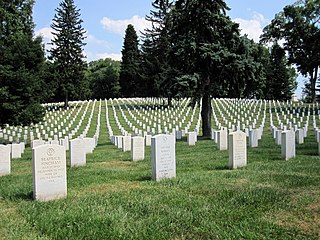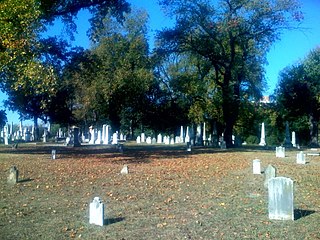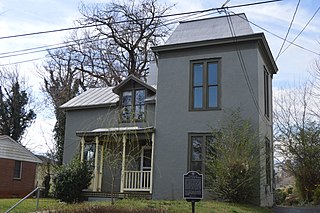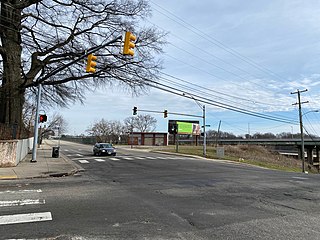
Arlington National Cemetery is one of two national cemeteries run by the United States Army. Nearly 400,000 people are buried in its 639 acres in Arlington, Virginia. There are about 30 funerals conducted on weekdays and 7 held on Saturday. The other Army cemetery is in Washington, D.C. and is called the U.S. Soldiers' and Airmen's Home National Cemetery. All other national cemeteries are run by the National Cemetery System of the Department of Veterans Affairs.

Alexandria National Cemetery is a United States National Cemetery, of approximately 5.5 acres (2.2 ha), located in the city of Alexandria, Virginia. Administered by the United States Department of Veterans Affairs, it is one of the original national cemeteries that were established in 1862. As of 2014, it was site to over 4,500 interments. The cemetery can accommodate the cremated remains of eligible individuals.

Culpeper National Cemetery is a United States National Cemetery located in the town of Culpeper, in Culpeper County, Virginia. Administered by the United States Department of Veterans Affairs, it encompasses 29.6 acres (120,000 m2) of land, and as 2021, had over 14,000 interments.

Winchester National Cemetery is a United States National Cemetery located in the city of Winchester in Frederick County, Virginia. Administered by the United States Department of Veterans Affairs, it encompasses 4.9 acres (2.0 ha), and as of the end of 2005, it had 5,561 interments. It is closed to new interments.

Richmond National Cemetery is a United States National Cemetery three miles (4.8 km) east of Richmond in Henrico County, Virginia. Administered by the United States Department of Veterans Affairs, it encompasses 9.7 acres (3.9 ha), and as of 2021 had more than 11,000 interments. It is closed to new interments. Richmond National Cemetery was listed on the National Register of Historic Places in 1995.

The Hebrew Cemetery in Richmond, Virginia, also known as Hebrew Burying Ground, dates from 1816. This Jewish cemetery, one of the oldest in the United States, was founded in 1816 as successor to the Franklin Street Burial Grounds of 1789. Among those interred here is Josephine Cohen Joel, who was well known in the early 20th century as the founder of Richmond Art Co. Within Hebrew Cemetery is a plot known as the Soldier's Section. It contains the graves of 30 Jewish Confederate soldiers who died in or near Richmond. It is one of only two Jewish military cemeteries outside of the State of Israel.

The Old City Cemetery is a historic cemetery in Lynchburg, Virginia. It is the oldest municipal (city-owned) cemetery still in use today in the state of Virginia, and one of the oldest such burial grounds in the United States. Since the 1990s it has been operated as a history park and arboretum, in addition to being an active cemetery.

The Shockoe Hill Cemetery is a historic cemetery located on Shockoe Hill in Richmond, Virginia.

Greenlawn Memorial Park, also known as Greenlawn Cemetery, is located at 2700 Parish Avenue, Newport News, Virginia. Greenlawn Memorial Park is a 50-acre (200,000 m2) cemetery located where two natural streams, Mill Dam Creek and Salters Creek, come together. The cemetery has been in continuous operation, serving the Newport News and Hampton, Virginia, since 1888. There are approximately 20,000 burials in the cemetery. Greenlawn Memorial Park is on the National Register of Historic Places.

Mount Zion African Methodist Episcopal Church and Mount Zion Cemetery is a historic church and cemetery located at 172 Garwin Road in Woolwich Township, New Jersey, United States. The church was a stop on the Greenwich Line of the Underground Railroad through South Jersey operated by Harriet Tubman for 10 years. The church provided supplies and shelter to runaway slaves on their way to Canada from the South. The church and cemetery were part of the early 19th-century free negro settlement sponsored by Quakers known as Small Gloucester.

Zion Evangelical Lutheran Church Cemetery is a historic Evangelical Lutheran cemetery and national historic district located near Speedwell, Wythe County, Virginia. The cemetery includes approximately 250–300 total gravestones. Forty two of the stones have dates ranging from the 1790s to 1840, but all were carved between about 1835 to 1840. It is likely that a skilled carver moved to the area in the mid-1830s and provided stones for many graves, which formerly had been marked with improvised stone or wooden markers, then completed his work by 1840. The thick sandstone markers are Germanic stones with surviving inscriptions.

East Hill Cemetery, also known as Maryland Hill, Round Hill, Rooster Hill, and City Cemetery, is a historic cemetery located at Bristol, Virginia. It is an American Civil War-era cemetery established in 1857, with sections for Confederate soldiers and veterans as well as a small section for African American burials. In 1995, the United Daughters of the Confederacy put up a small commemorative monument to the Civil War dead. Among its graves are the founders of the city, representatives of enslaved African-Americans, Civil War soldiers including those who died as a result of the war as well as those who survived the war, a Revolutionary War General of Militia Evan Shelby, and many who have made contributions to Bristol and the nation. It straddles the Tennessee-Virginia border.

Shannon Cemetery is a historic cemetery located near Pearisburg, Giles County, Virginia. It consists of two discontiguous sections, a white section and a black section, located approximately a thousand feet apart at about 1,900 feet in elevation above sea level. The white (south) section was established in 1781 and contains a variety of grave markers including inscribed and uninscribed fieldstones, decoratively carved tombstones of indigenous stone and imported marble, concrete markers, and twentieth century granite monuments. The black (north) section was established in the 19th century and has small uninscribed fieldstone markers and one professionally carved marble headstone. The Shannon Cemetery is believed to be the oldest maintained cemetery in the county.

Ivy Hill Cemetery is a historic rural cemetery and national historic district located at Smithfield, Isle of Wight County, Virginia. It was established in 1886, and is a privately owned cemetery. Grave markers within the cemetery date from the mid-19th century to the present day. It includes a number of notable funerary monuments.

Mount Zion Old School Baptist Church, also known as Mount Zion Primitive Baptist Church and Mount Zion Old School Predestinarian Baptist Church, is a historic Primitive Baptist church located at Gilberts Corner, Loudoun County, Virginia. It is now maintained by the Northern Virginia Regional Park Authority: the property including the adjoining cemetery is open from dawn to dusk and the church itself open on the fourth Sunday of various months, or by reservation for weddings and events.

Benjamin Tonsler House is a historic home located at Charlottesville, Virginia. It was built in 1879, and is a two-story, stuccoed frame Late Victorian dwelling with elements of the Italianate and Second Empire styles. It has a rear wing, high-pitched gable roof, and a projecting corner tower with a mansard roof.

Oak Lawn is a historic home located at Charlottesville, Virginia. The brick dwelling was built in 1822, and consists of a two-story, four bay, main block flanked by one-story, two bay wings. The central section has a front gable roof and one-story porch with a flat roof supported by four Tuscan order columns and topped by a second story balcony. Exterior chimneys arise between the main block and each of the wings. Also on the property are a contributing kitchen (1822) and two cemeteries. It was built by James Dinsmore, a Scots-Irish builder who worked for Thomas Jefferson.

Barton Heights Cemeteries is a set of six contiguous historic African-American cemeteries located in Richmond, Virginia, though were originally part of Henrico County. The cemeteries are the Cedarwood, originally called Phoenix and established in 1815, Union Mechanics, Methodist, Sycamore, Ebenezer, and Sons and Daughters of Ham cemeteries. The cemeteries were established between 1815 and circa 1879, and include hundreds of burials.

Mount Moriah Baptist Church and Cemetery is a historic African-American Baptist church and cemetery located at Roanoke, Virginia. It was built about 1908, and is a small, one-story, rectangular frame church sheathed in weatherboard. It consists of a main sanctuary, a front vestibule, and a rear chancel bay. The frame building sits on a raised foundation of uncoursed fieldstones. The associated burial ground contains over 100 interments from the 1870s through the present.

The Shockoe Hill African Burying Ground was established by the city of Richmond, Virginia, for the interment of free people of color, and the enslaved. The heart of this now invisible burying ground is located at 1305 N 5th St. It was created as the replacement for the Burial Ground for Negroes, now also called the Shockoe Bottom African Burial Ground,. Shockoe Bottom was known historically as Shockoe Valley. The Burial Ground for Negroes was closed in 1816 upon the opening of this new African Burying Ground on Shockoe Hill. The Shockoe Hill African Burying Ground is one of Virginia's most endangered historic places. Major threats to the burial ground are the DC2RVA high-speed rail project, the east-west Commonwealth Corridor, as well as the proposed widening of I-64, and various infrastructure projects.
























